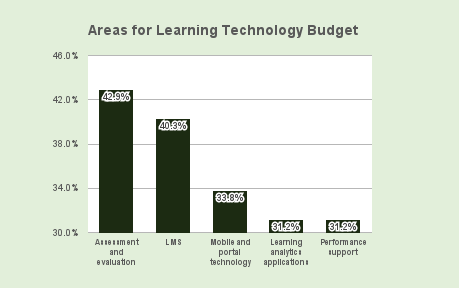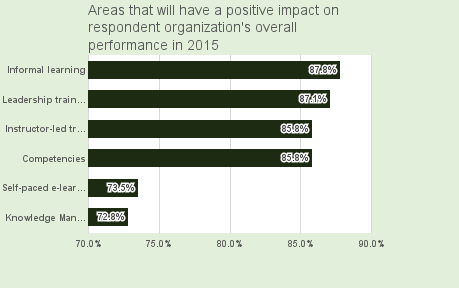
Economic forces, changing demographics, and technology are driving new investment in learning and development. Researcher and thought leader Josh Bersin is seeing a massive replacement of human resources system. Research from the Human Capital Institute by McLean & Company shows us that L&D is the top sending priority.

Data Source: "Enterprise Education that Lasts." (White Paper) Human Capital
Media Breakfast Club, April, 2015. Accessed November 18, 2015
These are the five major trends we see in 2015 and beyond.
- Measuring Business Outcomes. The tough economic climate of the past few years has driven learning leaders to align their efforts more closely with business objectives. We see a breakout from the tradition methods of measuring activity to assessing the outcome in terms of impact on the organization.
- Workforce Analytics. Workforce analytics has been a buzzword for a few years but analytics has yet to mature. While the skills to make it happen are still scarce, the technology and resources are reaching the mainstream. As Josh Bersin explains, we are on the cusp of explosive growth in the ability to make sense of workforce impact on business results.
- Mobile Learning. Mobile is transforming learning. Learning organizations can now deliver bite-size content to any device. Employees can start training on any device and continue it on another.
- Gamification. The new concept of gamification uses gaming technology and adaptive learning to help people learn skills while solving real problems. Gaming scenarios adapt as the learner progresses. In other interactive learning, adaptive technology adjusts an individual’s learning track based on periodic assessments.
- Social Learning. Peer-to-peer learning is growing, and people are building learning communities. These communities have existed for years in hobbies and home life, and people are bringing them into the workplace.
These changes are reactions to larger forces of change, driven by technology and cultural evolution.
The Pace of Change
Douglas Thomas and John Seely Brown, in A New Culture of Learning, demonstrate that old ways of learning cannot keep up with the pace of change. By the time a learner completes a course of study, the knowledge and skills needed to do the work have changed. The need for learning has become constant, and people are adapting to it. Thomas and Brown advocate a new culture of learning based on three principles:
“(1) The old ways of learning are unable to keep up with our rapidly changing world.
(2) New media forms are making peer-to-peer learning easier and more natural.
(3) Peer-to-peer learning is amplified by emerging technologies that shape the collective nature of participation with those new media.”
(Thomas, Douglas, and John Seely Brown. A New Culture of Learning: Cultivating the Imagination for a World of Constant Change. Lexington, KY, 2011.)
Instant Learning
The internet has matured into a massive learning machine. When people want to know how to do something, they can get practical training on any connected device, anywhere. They can find online learning on any subject from the latest recipes to doctoral-level courses at major universities.
People have come to expect instant on-demand learning at home, and they expect it in the workplace because it works. If they can use on-demand learning to create a new fishing lure, they can use it to solve a business problem.
Consumer Behavior
Buyers in business markets and retails consumers are more informed than ever. By the time they approach a seller, they have already learned more about the products than most longtime product owners knew ten years ago. People who interact with customers will need a different set of skills and instant access to detailed information.
Social Learning
Informal social learning is having a major impact on business productivity (see chart). One of our collaborators shared his real-world experience with us.

Data Source: "Enterprise Education that Lasts." (White Paper) Human Capital
Media Breakfast Club, April, 2015. Accessed November 18, 2015
“I had the exhilarating experience of working in a SaaS startup that was growing exponentially. We were acquiring new implementation consultants to keep up with customer demand while new innovations were coming out at a rapid pace. To keep up with the pace of knowledge growth, we used our phones, instant messaging, email and a wiki to create a learning and support community. Each of us became learners, innovators, coaches, and operators – all at the same time. Our learning community helped dominate the market.”
That’s the future of learning.
Pixentia is an enthusiastic team of individuals, fervent to make lives simpler through effective use of technology. Our mission is to implement solutions that drives business results. Know more insights from our thoughts and experience.
Contact us today or call 1-855-978-6816 to talk with us about your business needs.


